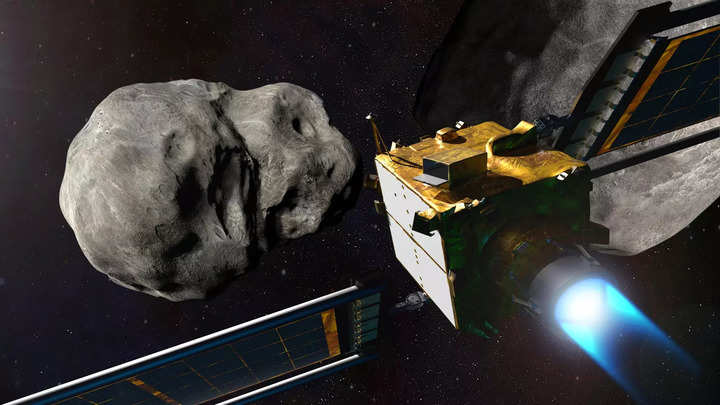NASA on spacecraft changed asteroid’s orbit after smashing into it
The US space agency has confirmed that when its spacecraft smashed into an asteroid last month, it altered its orbit by 32 minutes, calling it a “watershed moment” for planetary defence.
This marks humanity’s first time purposely changing the motion of a celestial object and the first full-scale demonstration of asteroid deflection technology.
After 10 months of flying in space, NASA‘s Double Asteroid Redirection Test (DART) — the world’s first planetary defence technology demonstration — successfully impacted its asteroid target called Dimorphos last month, the agency’s first attempt to move an asteroid in space.
Read Also


“This mission shows that NASA is trying to be ready for whatever the universe throws at us. NASA has proven we are serious as a defender of the planet,” said agency Administrator Bill Nelson.
“This is a watershed moment for planetary defense and all of humanity, demonstrating commitment from NASA’s exceptional team and partners from around the world,” Nelson said in a statement late on Tuesday.
Prior to DART’s impact, it took Dimorphos 11 hours and 55 minutes to orbit its larger parent asteroid, Didymos.
Now, the investigation team has confirmed that the spacecraft’s impact altered Dimorphos’ orbit around Didymos by 32 minutes, shortening the 11-hour and 55-minute orbit to 11 hours and 23 minutes.
This measurement has a margin of uncertainty of approximately plus or minus 2 minutes.
Before its encounter, NASA had defined a successful orbital period change of Dimorphos as a change of 73 seconds or more.
The early data show DART surpassed this minimum benchmark by more than 25 times.
“This result is one important step toward understanding the full effect of DART’s impact with its target asteroid,” said Lori Glaze, director of NASA’s Planetary Science Division at NASA Headquarters in Washington.
Glaze added that as new data comes in each day, astronomers will be able to better assess whether, and how, a mission like DART could be used in the future to help protect Earth from a collision with an asteroid if we ever discover one headed our way.
The investigation team is still acquiring data from ground-based observatories around the world.
“DART has given us some fascinating data about both asteroid properties and the effectiveness of a kinetic impactor as a planetary defence technology,” said Nancy Chabot, the DART coordination lead.
FacebookTwitterLinkedin

The US space agency has confirmed that when its spacecraft smashed into an asteroid last month, it altered its orbit by 32 minutes, calling it a “watershed moment” for planetary defence.
This marks humanity’s first time purposely changing the motion of a celestial object and the first full-scale demonstration of asteroid deflection technology.
After 10 months of flying in space, NASA‘s Double Asteroid Redirection Test (DART) — the world’s first planetary defence technology demonstration — successfully impacted its asteroid target called Dimorphos last month, the agency’s first attempt to move an asteroid in space.
Read Also


“This mission shows that NASA is trying to be ready for whatever the universe throws at us. NASA has proven we are serious as a defender of the planet,” said agency Administrator Bill Nelson.
“This is a watershed moment for planetary defense and all of humanity, demonstrating commitment from NASA’s exceptional team and partners from around the world,” Nelson said in a statement late on Tuesday.
Prior to DART’s impact, it took Dimorphos 11 hours and 55 minutes to orbit its larger parent asteroid, Didymos.
Now, the investigation team has confirmed that the spacecraft’s impact altered Dimorphos’ orbit around Didymos by 32 minutes, shortening the 11-hour and 55-minute orbit to 11 hours and 23 minutes.
This measurement has a margin of uncertainty of approximately plus or minus 2 minutes.
Before its encounter, NASA had defined a successful orbital period change of Dimorphos as a change of 73 seconds or more.
The early data show DART surpassed this minimum benchmark by more than 25 times.
“This result is one important step toward understanding the full effect of DART’s impact with its target asteroid,” said Lori Glaze, director of NASA’s Planetary Science Division at NASA Headquarters in Washington.
Glaze added that as new data comes in each day, astronomers will be able to better assess whether, and how, a mission like DART could be used in the future to help protect Earth from a collision with an asteroid if we ever discover one headed our way.
The investigation team is still acquiring data from ground-based observatories around the world.
“DART has given us some fascinating data about both asteroid properties and the effectiveness of a kinetic impactor as a planetary defence technology,” said Nancy Chabot, the DART coordination lead.
FacebookTwitterLinkedin
